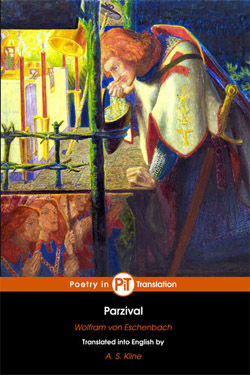Wolfram von Eschenbach
Parzival
In English translation with illustrations courtesy of the Birmingham Museums.

Lights before the Grail were borne;
No mean things, but bright as dawn
Book I - Gahmuret and Belacane
Book II - Gahmuret and Herzeloyde
Book III - The Young Parzival
Book IV - Parzival and Condwiramurs
Book V - The Grail Castle
Book VI - Vengeance on Sir Kay
Book VII - Gawain at Bearosche
Book VIII - Gawain at Schanpfanzun
Book IX - Parzival and Trevrizent
Book X - Gawain and Orgeluse
Book XI - Terre Marveile
Book XII - The Garland
Book XIII - King Arthur’s Expedition
Book XIV - Gramoflanz
Book XV - Feirefiz, the Infidel
Book XVI - The Grail King
About This Work
‘Parzival’ is dated, from internal and circumstantial evidence, to the first decade of the 13th century. The work is written in the East Franconian dialect of Middle High German. Its author Wolfram von Eschenbach was a contemporary of Gottfried von Strassburg, creator of the epic ‘Tristan’. Wolfram was Bavarian, and Hermann I of Thuringia appears to have been a major patron. ‘Parzival’ is an extensive development of Chrétien de Troyes’ unfinished ‘Perceval’, the first extant version of the Grail theme, though Wolfram, perhaps mischievously, claims an unknown poet, named Kyot, from Provence, as his source. ‘Parzival’ is a fine and representative work from the richest period of Medieval German poetry which, as well as ‘Tristan’, includes the courtly love-lyrics of the Minnesingers.
Translated by A. S. Kline © Copyright 2020 All Rights Reserved
This work may be freely reproduced, stored and transmitted, electronically or otherwise, for any non-commercial purpose. Conditions and Exceptions apply.
Last Modified 11th April 2020